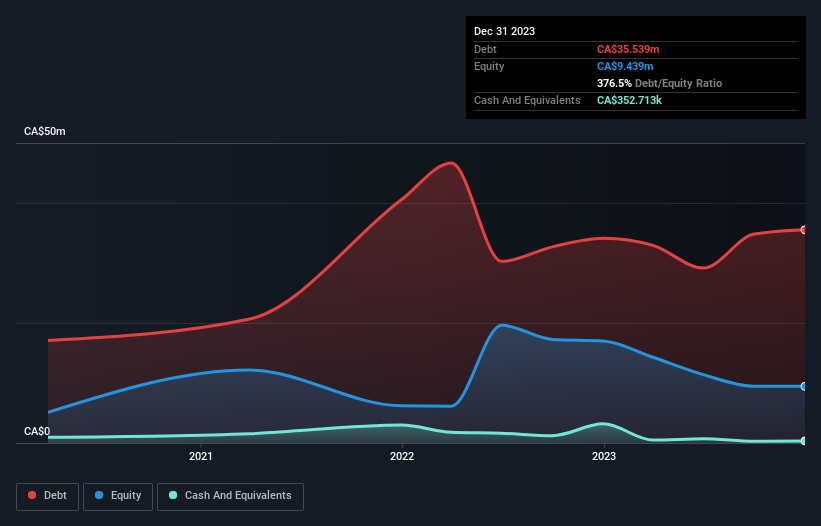Health Check: How Prudently Does Global Food and Ingredients (CVE:PEAS) Use Debt?

Howard Marks put it nicely when he said that, rather than worrying about share price volatility, 'The possibility of permanent loss is the risk I worry about... and every practical investor I know worries about.' So it seems the smart money knows that debt - which is usually involved in bankruptcies - is a very important factor, when you assess how risky a company is. We can see that Global Food and Ingredients Ltd. (CVE:PEAS) does use debt in its business. But is this debt a concern to shareholders?
Why Does Debt Bring Risk?
Debt assists a business until the business has trouble paying it off, either with new capital or with free cash flow. Ultimately, if the company can't fulfill its legal obligations to repay debt, shareholders could walk away with nothing. However, a more common (but still painful) scenario is that it has to raise new equity capital at a low price, thus permanently diluting shareholders. Of course, the upside of debt is that it often represents cheap capital, especially when it replaces dilution in a company with the ability to reinvest at high rates of return. When we examine debt levels, we first consider both cash and debt levels, together.
See our latest analysis for Global Food and Ingredients
What Is Global Food and Ingredients's Debt?
The image below, which you can click on for greater detail, shows that at December 2023 Global Food and Ingredients had debt of CA$35.5m, up from CA$34.1m in one year. And it doesn't have much cash, so its net debt is about the same.

A Look At Global Food and Ingredients' Liabilities
Zooming in on the latest balance sheet data, we can see that Global Food and Ingredients had liabilities of CA$36.8m due within 12 months and liabilities of CA$14.8m due beyond that. Offsetting these obligations, it had cash of CA$352.7k as well as receivables valued at CA$15.7m due within 12 months. So its liabilities total CA$35.5m more than the combination of its cash and short-term receivables.
The deficiency here weighs heavily on the CA$9.11m company itself, as if a child were struggling under the weight of an enormous back-pack full of books, his sports gear, and a trumpet. So we'd watch its balance sheet closely, without a doubt. At the end of the day, Global Food and Ingredients would probably need a major re-capitalization if its creditors were to demand repayment. There's no doubt that we learn most about debt from the balance sheet. But you can't view debt in total isolation; since Global Food and Ingredients will need earnings to service that debt. So when considering debt, it's definitely worth looking at the earnings trend. Click here for an interactive snapshot.
Over 12 months, Global Food and Ingredients made a loss at the EBIT level, and saw its revenue drop to CA$106m, which is a fall of 17%. That's not what we would hope to see.
Caveat Emptor
Not only did Global Food and Ingredients's revenue slip over the last twelve months, but it also produced negative earnings before interest and tax (EBIT). Its EBIT loss was a whopping CA$5.0m. Combining this information with the significant liabilities we already touched on makes us very hesitant about this stock, to say the least. Of course, it may be able to improve its situation with a bit of luck and good execution. But we think that is unlikely, given it is low on liquid assets, and burned through CA$1.7m in the last year. So we think this stock is risky, like walking through a dirty dog park with a mask on. When analysing debt levels, the balance sheet is the obvious place to start. However, not all investment risk resides within the balance sheet - far from it. Be aware that Global Food and Ingredients is showing 4 warning signs in our investment analysis , you should know about...
At the end of the day, it's often better to focus on companies that are free from net debt. You can access our special list of such companies (all with a track record of profit growth). It's free.
New: Manage All Your Stock Portfolios in One Place
We've created the ultimate portfolio companion for stock investors, and it's free.
• Connect an unlimited number of Portfolios and see your total in one currency
• Be alerted to new Warning Signs or Risks via email or mobile
• Track the Fair Value of your stocks
Have feedback on this article? Concerned about the content? Get in touch with us directly. Alternatively, email editorial-team (at) simplywallst.com.
This article by Simply Wall St is general in nature. We provide commentary based on historical data and analyst forecasts only using an unbiased methodology and our articles are not intended to be financial advice. It does not constitute a recommendation to buy or sell any stock, and does not take account of your objectives, or your financial situation. We aim to bring you long-term focused analysis driven by fundamental data. Note that our analysis may not factor in the latest price-sensitive company announcements or qualitative material. Simply Wall St has no position in any stocks mentioned.
About TSXV:PEAS.H
Global Food and Ingredients
A plant-based food and ingredients company, supplies plant-based high protein ingredients in North America, Asia, Europe, South America, and internationally.
Mediocre balance sheet low.
Market Insights
Community Narratives



